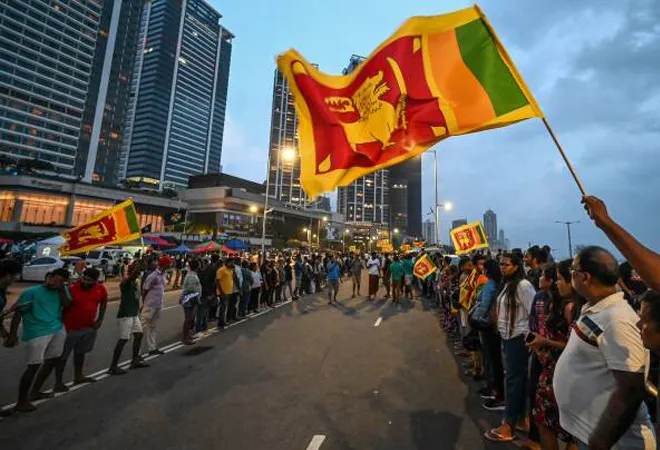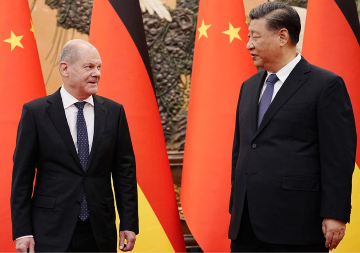
Sri Lanka has got a
new Prime Minister, Ranil Wickremesinghe, under most unenviable circumstances. Unlike what the Indian public believes, the Sri Lankan prime minister’s job is vastly different from that of their Indian counterpart. Until President Gotabaya Rajapaksa gets the
Constitution amended to end the controversial Executive Presidency and empowers the Prime Minister and his Cabinet through Parliament, the political impasse of the past weeks will continue, one way or the other. A constitutional debate on whittling down the Executive Presidency is going to consume more time and energy than already, further delaying the roadmap for economic recovery.
As a friendly neighbour, India has multiple roles assigned by anxious citizens for Sri Lanka’s political stability, economic recovery, and strategic security. It owes not only to India’s own needs, as often wrongly surmised in Sri Lanka but owes even more to Indian concerns that Sri Lanka does not end up with a ‘failed state’ tag as many had branded Pakistan in the neighbourhood. Nor should Sri Lanka become a ‘basket case’ as the West had dubbed Bangladesh at Independence.
The Gota presidency should owe the last straws, like sacrificing 25-percent tax revenue, slashing the taxpayers’ list by a million, banning the import of essentials without a thought, and taking to ‘organic fertilizers’ overnight, without prior consultations, preparations, education, and stocks.
Plain and simple, Sri Lanka lived beyond its means. The Gota presidency should owe the last straws, like sacrificing 25-percent tax revenue, slashing the taxpayers’ list by a million, banning the import of essentials without a thought, and taking to ‘organic fertilizers’ overnight, without prior consultations, preparations, education, and stocks. But the economic and forex crises of the present are a ‘legacy issue’ for which all are equally responsible, ever since the economic reforms in 1978.
Anand model
As the new Prime Minister, Ranil Wickremesinghe should have the courage to own up for having introduced lop-sided economic reforms in 1978. This caused imported dairy products from New Zealand and Australia to kill the local village-based industry. These exporter-nations now should have the grace to assist in the re-discovery of Sri Lanka’s traditional dairy industry, and also help identify new export markets.
India, for instance, has the successful
‘Anand’ model that could help re-create the Sri Lankan dairy industry. This could restore the confidence of the rural population in the changing times, also put some cash into their pockets, and possibly also cut down import-bill by a certain degree. India also had an agreement for bi-annual gifting of 25,000 cattle-heads to Upcountry Tamils of recent Indian origin, or ‘Estate’ Tamils. New Delhi can revive the project and extend the scheme to all parts of Sri Lanka, as fast as it can.
Tea, incidentally linked to the lives and livelihoods of the ‘Estate Tamils’, is another export commodity that has been badly hit by Gota’s ‘organic fertiliser’ scheme. With no forex reserve to import cloth from Southeast Asia, Sri Lanka’s value-added textile exports have also been hit. Indications are that Indian suppliers, especially from the South, have benefited. While the new Sri Lankan government helps restore market confidence in the nation, New Delhi too may have to work with its industries, to see if the re-routed global trade did not adversely impact the neighbourhood economy more than already. These require grassroots-level discussions and adjustments at multiple levels.
Tourism is the third Sri Lankan forex earner and a major one at that. It’s the one worst hit, beginning with the 2019 Easter serial blasts, followed by the global COVID-19 lockdowns. The current phase of unending political instability, in the face of the forex crisis, food and fuel shortage, hitting both the hospitality industry and transport sector, has worsened the situation when the nation was on the road to recovery. Using Sri Lanka’s current tourism plight, and Maldives’ successful recovery mode, the Indian industry can be encouraged to build the elusive tourism-hub model, to which Bhutan and Nepal too can be added in due course.
Tourism is the third Sri Lankan forex earner and a major one at that. It’s the one worst hit, beginning with the 2019 Easter serial blasts, followed by the global COVID-19 lockdowns.
In the post-war era, the government of then-President Mahinda Rajapaksa invited reputed Indian agronomists and also IT czars, to re-build the former and create an IT/ITE industry, for local and export markets. Under threats from pan-Tamil elements in South India, they backed out. The government filled the agriculture revival in the war-ravaged areas of Sri Lanka. This, New Delhi can revive across that country and also look at joint IT sector development.
Ensuring political stability
India’s continuing humanitarian assistance, aimed exclusively at aiding the people, has been mischievously interpreted in Sri Lanka as New Delhi propping up the ‘unpopular’ Rajapaksas in office. This has found unfortunate resonance in some responsible circles in India. Even the worst critics of Rajapaksas in their nation have not pointed to any particular Indian aid-assistance, including credit-swap, etc., going to bolster the Rajapaksas, personally or politically—as the past Chinese assistance (alone) had done.
The simple truth is that India’s assistance is for the Sri Lankan people, and it can operate only through government leadership. It was the Rajapaksas exclusively until now, but the new Prime Minister Ranil Wickremesinghe would have a share of the credit (in distribution) if he clears the trust votes in the Parliament. It could be someone else if fresh elections, whenever held, throws up new leaders to office, whatever form of government they have at the time.
Beyond this, suggestions nearer home for New Delhi to play the facilitator to help Sri Lankans resolve the current political impasse, are based on an inadequate understanding of that nation’s history, social, and political culture, of which the visible ethnic differences are only a part. Though not much is reported in the media, anti-India slogans were known to have been raised at various anti-Rajapaksa protest venues, including pockets in Galle Face Green, the
urban venue of what was touted as the nation’s ‘Arab Spring’.
India also paid a heavy price in the life of former Prime Minister Rajiv Gandhi, when the LTTE assassinated him (1991), for their perception of his failed role in the Sri Lankan peace process, Indo-Sri Lanka Accord and the induction of the IPKF (both in 1987).
While most Sri Lankans, cutting across ethnicities, languages, and other internal divisions, are thankful for India’s live-saving gesture of the past weeks, there are still those that do benefit from New Delhi’s largesse and yet continue with their traditional anti-India posturing, without any justification. Post-protests, whenever, there may thus be a need to make a closer study of the dynamics of such sloganeering, to apply political and diplomatic correctives, where needed and possible.
In this background, and given the added complexities of the hour, nations, not excluding India, would do well not to go to Sri Lankans with their textbook template models for ‘problem-solving’ and ‘conflict-resolution’, militant or otherwise. India, Norway, and to a lesser extent Japan burnt their fingers over facilitating peace talks to the decades-old ethnic crisis, as local stakeholders ended up accusing the facilitator of taking the other side. India also paid a heavy price in the life of former Prime Minister Rajiv Gandhi, when the LTTE assassinated him (1991), for their perception of his failed role in the Sri Lankan peace process, Indo-Sri Lanka Accord and the induction of the IPKF (both in 1987). Over 1,500 Indian soldiers lost their lives in a call of duty that was not theirs, to begin with.
It’s again Sri Lankans’ job
This is another area where Sri Lanka has to resolve its internal strife, which showed unshakable evidence of impending violence, more than already, especially if the political drift is allowed to continue. The pro-Mahinda rioters are identifiable, but no one has taken responsibility for the retaliatory arson, which was targeted and executed with precision.
The new government will have to focus rapid attention on investigating these cases early, as already the Catholic Church is peeved at the alleged delays and manipulation of the probe and prosecution in the ‘Easter blasts’ case (2019). As is acknowledged, Indian agencies had shared in advance, actionable intelligence on the impending disaster, but to no avail. Instead, there were those in Sri Lanka who accused India of plotting the blasts, and, yes, to promote the Rajapaksas’ electoral victories that followed.
The defence ministry has since clarified that Mahinda is being housed in the Trincomalee naval base as a former President entitled to security under such trying circumstances, and not necessarily otherwise.
Like any other nation, Sri Lanka has a professional army, whose leadership has repeatedly avowed their loyalty to the Sri Lankan state (translating as whoever is the President and Supreme Commander), and not to any person in particular. This much was visible when Mahinda left office, unsung, almost unprotected. The defence ministry has since clarified that Mahinda is being housed in the Trincomalee naval base as a former President entitled to security under such trying circumstances, and not necessarily otherwise.
If left unresolved for long, the arson cases, for instance, could trigger anxieties, and also trigger possibilities of expanded activities of the kind, since attributed to erstwhile left militant JVP and the breakaway Frontline Socialist Party (FSP). Leaving such suspicions and doubts unaddressed and fully resolved can complicate security perceptions in Sri Lanka. In turn, this can complicate things for India, where too left militancy is not yet a thing of the past, as is often made out to be. Here, intelligence-sharing and the rest can help both nations, unconnected to rumours of India having to send troops to Sri Lanka, which has enough and more of them—and which reports the Indian High Commission in Colombo has
promptly denied, since.
The views expressed above belong to the author(s). ORF research and analyses now available on Telegram! Click here to access our curated content — blogs, longforms and interviews.



 Sri Lanka has got a
Sri Lanka has got a  PREV
PREV


